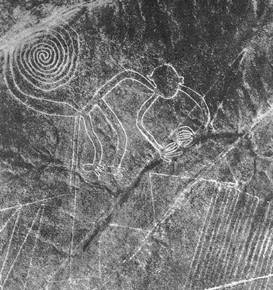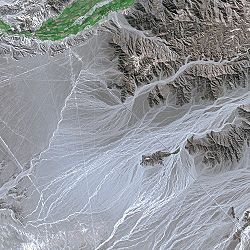Difference between revisions of "Nazca Lines" - New World Encyclopedia
Vicki Phelps (talk | contribs) m (→References) |
|||
| Line 1: | Line 1: | ||
| + | {{coord|14|43|00|S|75|08|00|W|type:city_scale:20000|display=title}} | ||
{{coord|14|43|00|S|75|08|00|W|type:city_scale:20000|display=title}} | {{coord|14|43|00|S|75|08|00|W|type:city_scale:20000|display=title}} | ||
{{Infobox World Heritage Site | {{Infobox World Heritage Site | ||
Revision as of 17:17, 30 November 2008
Coordinates: Coordinates:
| Lines and Geoglyphs of Nazca and Pampas de Jumana* | |
|---|---|
| UNESCO World Heritage Site | |

| |
| State Party | |
| Type | Cultural |
| Criteria | i, iii, iv |
| Reference | 700 |
| Region** | Latin America and the Caribbean |
| Inscription history | |
| Inscription | 1994 (18th Session) |
| * Name as inscribed on World Heritage List. ** Region as classified by UNESCO. | |
The Nazca lines are a series of geoglyphs located in the Nazca Desert, a high arid plateau that stretches more than 80 km (50 miles) between the towns of Nazca and Palpa on the Pampas de Jumana in Peru. They are believed to have been created by the Nazca culture between 200 B.C.E. and 700 C.E. There are hundreds of individual figures, ranging in complexity from simple lines to stylized hummingbirds, spiders, monkeys, fish, sharks, llamas and lizards.
The lines are shallow designs where the reddish pebbles that cover the surrounding landscape have been removed, revealing the whitish earth underneath. Hundreds are simple lines or geometric shapes, and more than seventy are natural or human figures. The largest are over 200m across. Scholars differ in interpreting what the lines were for but generally ascribe religious significance to them. The dry, windless, stable climate of the plateau has preserved the lines to this day.
Construction
The leading explanation for the method of construction employed by the Nazca people involves the use of simple tools and surveying equipment. Wooden stakes in the ground at the end of some lines (which were used to carbon-date the figures) and ceramics found on the surface support this theory. Furthermore, researcher Joe Nickell of the University of Kentucky has reproduced the figures using the technology available to the Nazca people of the time and without aerial assistance. With careful planning and simple technologies, a small team of individuals could recreate even the largest figures within days. Contrary to the claims of several commentators, the figures can be observed from the ground by standing on top of nearby foothills.[1]
The lines were made by removing the reddish-brown iron oxide coated pebbles which cover the surface of the Nazca desert. When the gravel is removed, the lines contrast sharply with the light-colored earth beneath. There are several hundred simple lines and geometric patterns on the Nazca plateau, as well as over seventy curvilinear animal and human figures. The area encompassing the lines is nearly 500 square kilometers (193 square miles), and the largest figures can be nearly 270 m long (886 feet). The lines persist due to the extremely dry, windless, and constant climate of the Nazca region. The Nazca desert is one of the driest on Earth and maintains a temperature around 77°F (25°C) all year round, and the lack of wind has helped keep the lines uncovered to the present day.
Purpose
The exact reason the figures were built remains a mystery. A leading theory is that the Nazca people's motivations were religious, and that the images were constructed so that gods in the sky could see them. Kosok and Reiche advanced one of the earliest reasons given for the Nazca Lines: that they were intended to point to the places on the distant horizon where the Sun and other celestial bodies rose or set. This hypothesis was evaluated by two different experts in archaeoastronomy, Gerald Hawkins and Anthony Aveni, and they both concluded that there was insufficient evidence to support an astronomical explanation.
In 1985, the archaeologist Johan Reinhard published archaeological, ethnographic, and historical data demonstrating that worship of mountains and other water sources played a dominant role in Nazca religion and economy from ancient to recent times. He presented the theory that the lines and figures can be explained as part of religious practices involving the worship of deities associated with the availability of water and thus the fertility of crops. The lines were interpreted as being primarily used as sacred paths leading to places where these deities could be worshiped and the figures as symbolically representing animals and objects meant to invoke their aid. However, the precise meanings of many of the individual geoglyphs remain unsolved.
Another theory contends that the lines are the remains of "walking temples," where a large group of worshipers walked along a preset pattern dedicated to a particular holy entity, similar to the practice of labyrinth walking. Residents of the local villages say the ancient Nazca conducted rituals on these giant drawings to thank the gods and to ensure that water would continue to flow from the Andes.[citation needed] This view correlates with the purposes of North American geoglyphs.[citation needed]
Notwithstanding Gerald Hawkins' and Anthony Aveni's dismissal of an astronomical explanation of the Nazca Lines and geoglyphs, astronomer Robin Edgar has theorized that the Nazca Lines, particularly the biomorph geoglyphs that depict animals, human figures, birds and "flowers" are an ancient response to what he called the"Eye of God" that is manifested in the sky during a total solar eclipse. According to Edgar, an unusual series of total solar eclipses over southern Peru coincided with the time period during which the Nazca Lines and geoglyphs were created.[citation needed]
Some, such as Jim Woodmann, have proposed that the Nazca lines presuppose some form of manned flight, in order to properly see the figures, and that a hot air balloon was the only possible available technology. Woodmann actually made a hot air balloon from materials and using techniques that he believed would have been available to people at the time to test this hypothesis. The balloon flew, after a fashion, but there is no evidence in support of Nazca-era hot air balloons [2] and Woodman's work has been rebutted.[1]
Environmental concerns
According to Viktoria Nikitzki of the Maria Reiche Centre, an organization dedicated to protecting the Nazca Lines, pollution and erosion caused by deforestation threaten the continued existence of the lines. She is quoted as saying "The Lines themselves are superficial, they are only 10 to 30cm deep and could be washed away... Nazca has only ever received a small amount of rain. But now there are great changes to the weather all over the world. The Lines cannot resist heavy rain without being damaged."[3] Mario Olaechea Aquije, the archaeological resident from Peru's National Institute of Culture in Nazca, Peru, and a team of specialists surveyed the area after the flooding and mudslides occurring in the area in mid-February of 2007. He announced that "the mudslides and heavy rains did not appear to have caused any significant damage to the Nazca Lines," but that the nearby Southern Pan-American Highway did suffer damage, and "the damage done to the roads should serve as a reminder to just how fragile these figures are."[4]
Google map links for Nazca lines
- http://maps.google.com/maps?f=q&hl=en&geocode=&q=palpa+peru&sll=-14.410075,-75.068207&sspn=0.299269,0.617981&ie=UTF8&ll=-14.695859,-75.177727&spn=0.00934,0.019312&t=h&z=16
- http://maps.google.com/maps?f=q&hl=en&geocode=&q=palpa+peru&sll=-14.410075,-75.068207&sspn=0.299269,0.617981&ie=UTF8&ll=-14.693067,-75.154402&spn=0.00467,0.009656&t=h&z=17
- The Nazca Lines from the Satellite and Videos
ReferencesISBN links support NWE through referral fees
- Aveni, Anthony F. (ed.) (1990). The Lines of Nazca. Philadelphia: American Philosophical Society. ISBN 0-87169-183-3
- Aveni, Anthony F. (2000). Between the Lines: The Mystery of the Giant Ground Drawings of Ancient Nasca, Peru . Austin Texas: University of Texas Press. ISBN 0-292-70496-8
- Haughton, Brian. (2007). Hidden History: Lost Civilizations, Secret Knowledge, and Ancient Mysteries. Career Press. ISBN 1564148971
- Lambers, Karsten (2006). The Geoglyphs of Palpa, Peru: Documentation, Analysis, and Interpretation. Lindensoft Verlag, Aichwald/Germany. ISBN 3-929290-32-4
- Reinhard, Johan (1996) (6th ed.) The Nazca Lines: A New Perspective on their Origin and Meaning. Lima: Los Pinos. ISBN 84-89291-17-9
Notes
- ↑ 1.0 1.1 http://www.hallofmaat.com/modules.php?name=Articles&file=article&sid=96 Grounding the Nasca Balloon by Katherine Reece
- ↑ Haughton (2007)
- ↑ Meghji, Shafik. " Flooding and tourism threaten Peru's mysterious Nazca Lines", The Independent, July 17, 2004. Accessed April 02, 2007.
- ↑ Living in Peru. "Peru: Nazca Lines escape mudslides", Living in Peru, February 20, 2007. Accessed April 02, 2007.
External links
Nazca lines at the Open Directory Project
Credits
New World Encyclopedia writers and editors rewrote and completed the Wikipedia article in accordance with New World Encyclopedia standards. This article abides by terms of the Creative Commons CC-by-sa 3.0 License (CC-by-sa), which may be used and disseminated with proper attribution. Credit is due under the terms of this license that can reference both the New World Encyclopedia contributors and the selfless volunteer contributors of the Wikimedia Foundation. To cite this article click here for a list of acceptable citing formats.The history of earlier contributions by wikipedians is accessible to researchers here:
The history of this article since it was imported to New World Encyclopedia:
Note: Some restrictions may apply to use of individual images which are separately licensed.

